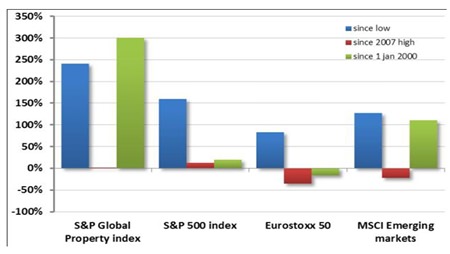Many people were more than a tad surprised when Alan Greenspan, economist and former chairman of the U.S. Federal Reserve, stated recently that share prices were “relatively low”. This is especially so given that the S&P 500 index has produced returns of around 160% since the bad old days of early 2009.
It must be admitted though this was from an incredibly low starting point. It is also interesting to note that Greenspan’s comments are actually supported by the Fed model, a valuation method that this great institution developed during his time as chairman.
 Source: Bloomberg – October 2013.
Source: Bloomberg – October 2013.
What this model does is to basically compare earnings estimates to treasury yields and, working on this basis, the potential return from equities is still favourable compared to bonds. “Equity premiums are still at a very high level, and that means that the momentum of the market is still ultimately up,” Greenspan said.
The present rally is very much driven by the wall of money hitting markets fresh off the QE presses which are run by the U.S. Federal Reserve and the Bank of Japan as well as a host of other countries. Even though things might look like they are a bit bubbly at the moment, there seems to be no good reason to fight against the momentum that is currently happening. In fact, riding the tide does not only seem to be less risky than perceived, but actually the right thing to do as things stand at the moment. The only thing to remember is to remain very liquid so that when things start on the downward trend you can get out quickly.
It sometimes is very hard, when managing money based on fundamental factors, to distinguish between how logic dictates how markets should behave and how they are likely to behave. Thus, at present, it does not really matter whether you believe the right thing is being done by printing more money or not, as the fact is it is happening anyway.
The wise course of action, at the moment, is to focus on which areas within liquidity driven risk asset markets to be exposed to, as the divergence in returns up to now, combined with differing factors driving specific markets, has left massive disparities between valuation levels.
The chart on this page compares a few indices in Dollars over various periods and shows that the S&P is one of very few markets that have actually reached new highs and erased the losses that resulted from the Global Financial Crisis.
Even though the allocation decision remains the largest driver of returns, the potential for alpha generation (especially in Global Equity Funds) is currently massive in my opinion – this is not the time to be hugging benchmarks.
This is not to say that whatever underperformed will necessarily outperform going forward; it only aims to illustrate how dispersed returns can be over specific periods of time when comparing apples with apples (i.e. all in same currency) and even though correlations between different equity markets are perceived to be high, the direction might be the same whilst the quantum of gains and losses are not related. Basically, equities are not a bad thing to be in at the moment but, as stated above, remain liquid.
| The above data and research was compiled from sources believed to be reliable. However, neither MBMG International Ltd nor its officers can accept any liability for any errors or omissions in the above article nor bear any responsibility for any losses achieved as a result of any actions taken or not taken as a consequence of reading the above article. For more information please contact Graham Macdonald on [email protected] |




